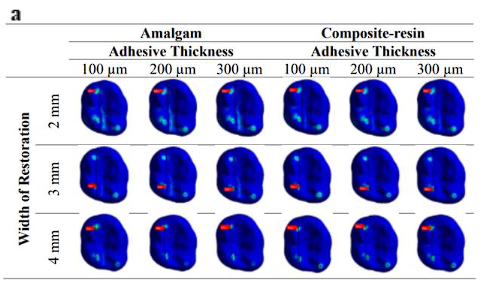Influence of Width, Material Type and Layer Thickness of Adhesive on Stress Distribution in Second Molar Restoration by Finite Element Method
doi: 10.14456/mijet.2022.35
Keywords:
finite element method, tooth restoration geometry, amalgam, composite resin, adhesive interface, von Mises stressAbstract
The objective of this study was to measure the effect of material type, layer thickness of adhesive, and width of restoration in the second molar to stress distribution and maximum stress at three positions: enamel, restoration and adhesive layer. The model had two types of material (Amalgam and Composite-resin). Each material had three thicknesses of adhesive (100, 200 and 300 µm) and three widths of restoration (2, 3 and 4 mm), to summarize there were 18 models. The model had a depth of the cavity of 2 mm and the base radius of the cavity was 0.5 mm. Three mechanical loads of 100 N (total of 300 N.), were applied on three occlusal contact points on the crown. This research was analyzed by using von Mises stress on enamel, restoration and adhesive layer. The results of this study were that with forces at three points, the maximum stress in the second molars, with restoration adhesive thicknesses of 100, 200 and 300 µm, were equal to 476.46, 462.80 and 309.01 MPa, respectively, while the width of the restoration was 4 mm and it was Amalgam material. All three models had the maximum stress distribution on the same restoration layer. The width of the restoration and the type of material affected the maximum stress in the molar teeth, but the thickness of the adhesive layer had little or no effect on the maximum stress in the molar teeth. In conclusion, the occlusal forces that occur at the junction of the enamel, material and adhesive layer had higher stress than in the other areas, so for safety and to reduce damage avoid grinding the dentin in this area.
References
S. Pai, V. Bhat, V. Patil, N. Naik, S. Awasthi, and N. Nayak,
"Numerical three-dimensional finite element modeling of cavity
shape and optimal material selection by analysis of stress
distribution on class v cavities of mandibular premolars," Journal
of International Society of Preventive and Community Dentistry,
vol. 10, no. 3, pp. 279–285, May 2020.
M. L. Mei, Y. M. Chen, H. Li, and C. H. Chu, "Influence of the
indirect restoration design on the fracture resistance: A finite
element study," BioMedical Engineering Online, vol. 15, no. 1, pp.
, Jan. 2016.
L. M. Campaner, A. B. Alves Pinto, A. M. Demachkia, T. J. de A.
Paes-Junior, C. Pagani, and A. L. S. Borges, "Influence of Cement
Thickness on the Polymerization Shrinkage Stress of Adhesively
Cemented Composite Inlays: Photoelastic and Finite Element
Analysis, " Oral, vol. 1, no. 2, pp. 168–180, Jun. 2021.
G. Couegnat, S. L. Fok, J. E. Cooper, and A. J. E. Qualtrough,
"Structural optimization of dental restorations using the principle
of adaptive growth," Dental Materials, vol. 22, no. 1, pp. 3–12,
Jan. 2006.
"Finite element analysis of thermal stress distribution in different
restorative materials used in class V cavities | Nigerian Journal of
Clinical Practice,"
https://www.ajol.info/index.php/njcp/article/view/129347
[Accessed: Apr. 03, 2021].
"Finite element analysis of stress concentration in Class V
restorations of four groups of restorative materials in mandibular
premolar,"
https://www.ncbi.nlm.nih.gov/pmc/articles/PMC2813101/
[Accessed: Apr. 03, 2021].
B. Babaei, P. Shouha, V. Birman, P. Farrar, L. Prentice, and G.
Prusty, "The effect of dental restoration geometry and material
properties on biomechanical behaviour of a treated molar tooth: A
D finite element analysis," Journal of the Mechanical Behavior of
Biomedical Materials, vol. 125, pp. 104892, Jan. 2022.
P. Ausiello, A. Apicella, and C. L. Davidson, "Effect of adhesive
layer properties on stress distribution in composite restorations -A
D finite element analysis," Dental Materials, vol. 18, no. 4, pp.
–303, Jun. 2002.
"Wheeler’s Dental Anatomy, Physiology and Occlusion - EBook
- Stanley J. Nelson"
https://books.google.co.th/books?hl=th&lr=&id=BM5sBQAAQB
AJ&oi=fnd&pg=PP1&dq=Ash+MM,+Nelson+SJ.&ots=32SGiGS
OKL&sig=ZnkZIxPEWgdkfPPIKNKRZ5XsyIA&redir_esc=y#v=
onepage&q&f=false [Accessed: Dec. 02, 2021].
S. Kotb, A. Shaker, and C. Halim, "Fatigue resistance and 3D
finite element analysis of machine-milled ceramic occlusal veneers
with new preparation designs versus conventional design: an in
vitro study," F1000Research 2019 8:1038, vol. 8, p. 1038, Jul.
B. Dejak, A. Młotkowski, and C. Langot, "Three-dimensional
finite element analysis of molars with thin-walled prosthetic
crowns made of various materials," Dental Materials, vol. 28, no.
, pp. 433–441, Apr. 2012.
"Teeth - Re-er,"
https://www.reer.net/content/17980/%E0%B8%9F%E0%B8%B
%E0%B8%99-teeth [Accessed: Apr. 03, 2021].
C. Holberg, P. Winterhalder, A. Wichelhaus, R. Hickel, and K.
Huth, "Fracture risk of lithium-disilicate ceramic inlays: A finite
element analysis," Dental Materials, vol. 29, no. 12, pp. 1244–
, Dec. 2013.
K. X. Xie, X. Y. Wang, X. J. Gao, C. Y. Yuan, J. X. Li, and C. H.
Chu, "Fracture resistance of root filled premolar teeth restored
with direct composite resin with or without cusp coverage, "
International Endodontic Journal, vol. 45, no. 6, pp. 524–529, Jun.
A. Prakki, R. Cilli, A. U. da Costa, S. E. de Paiva Gonçalves, R. F.
Lia Mondelli, and J. C. Pereira, "Effect of Resin Luting Film
Thickness on Fracture Resistance of a Ceramic Cemented to
Dentin, " Journal of Prosthodontics, vol. 16, no. 3, pp. 172–178,
May 2007.
A. Qureshi, E. Soujanya, N. Kumar, P. Kumar, and S. Hivarao,
"Recent advances in pulp capping materials: An overview,"
Journal of Clinical and Diagnostic Research, vol. 8, no. 1, pp.
–321, Jan. 2014.
V. P. Orlovskii, V. S. Komlev, and S. M. Barinov,
"Hydroxyapatite and hydroxyapatite-based ceramics," Inorganic
Materials, vol. 38, no. 10, pp. 973–984, Oct. 2002.
P. Ausiello, P. Franciosa, M. Martorelli, and D. C. Watts,
"Numerical fatigue 3D-FE modeling of indirect
compositerestored posterior teeth," Dental Materials, vol. 27, no.
, pp. 423–430, May 2011.
Y. Yaman, "Analysis of stress distribution in a maxillary central
incisor subjected to various post and core applications," Journal of
Endodontics, vol. 24, no. 2, pp. 107–111, Feb. 1998.
M. Bakke, "Bite Force and Occlusion," Seminars in Orthodontics,
vol. 12, no. 2, pp. 120–126, Jun. 2006.
P. Ausiello, S. Ciaramella, M. Martorelli, A. Lanzotti, A. Gloria,
and D. C. Watts, "CAD-FE modeling and analysis of class II
restorations incorporating resin-composite, glass ionomer and
glass ceramic materials," Dental Materials, vol. 33, no. 12, pp.
–1465, Dec. 2017.
"Mesh Element Quality and Size,"
https://doc.comsol.com/5.5/doc/com.comsol.help.comsol/comsol_r
ef_mesh.15.18.html?fbclid=IwAR1H3I6b6RuuIGe8aWduHGGD
XYarkovX9J_Qsdu8nHhGRC2ip4IMUHV943k [Accessed: Feb.
, 2022].
H. Yang et al., "Stress distribution in premolars restored with
inlays or onlays: 3D finite element analysis," The Journal of
Advanced Prosthodontics, vol. 10, no. 3, pp. 184–190, Jun. 2018.
E. J. S. Harold O. Heymann, Sturdevant’s Art & Science of
Operative Dentistry - E-Book,
https://books.google.co.th/books?id=IMbsAwAAQBAJ&pg=PA1
&lpg=PA142&dq=outline%20form%20to%20avoid%
[Accessed: Apr. 07, 2022].
S. Y. Kim, B. S. Kim, H. Kim, and S. Y. Cho, "Occlusal stress
distribution and remaining crack propagation of a cracked tooth
treated with different materials and designs: 3D finite element
analysis," Dental Materials, vol. 37, no. 4, pp. 731–740, Apr.
J. P. M. Tribst, A. M. de O. Dal Piva, M. M. Penteado, A. L. S.
Borges, and M. A. Bottino, "Influence of ceramic material,
thickness of restoration and cement layer on stress distribution of
occlusal veneers," Braz Oral Res, vol. 32, p. e118, Nov. 2018

Downloads
Published
How to Cite
Issue
Section
License

This work is licensed under a Creative Commons Attribution-NonCommercial-NoDerivatives 4.0 International License.








